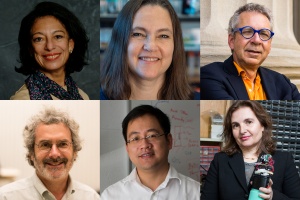Nazli Choucri Connects the Dots Between Technology and Geopolitics
If there’s anything the last few months of current events in the U.S. has made starkly clear, it’s that seemingly distinct entities in our lives — such as social media, politics and conflict, just to name a few — are much more interconnected in ways that few of us may see or understand.

In 2020, Dr. Nazli Choucri was elected as a AAAS Fellow for her work on international relations, cybersecurity and global sustainability solutions.
Image: Stuart Darsch
If there’s anything the last few months of current events in the U.S. has made starkly clear, it’s that seemingly distinct entities in our lives — such as social media, politics and conflict, just to name a few — are much more interconnected in ways that few of us may see or understand.
Identifying those connections is a large part of the formidable body of work conducted by AAAS Member Nazli Choucri, Ph.D., a professor of political science and a senior faculty member at the Center of International Studies (CIS) and a faculty affiliate at the Institute for Data, Science, and Society (IDSS) at the Massachusetts Institute of Technology (MIT). In 2020, Dr. Choucri was elected as a AAAS Fellow for her work on international relations, cybersecurity and global sustainability solutions.
“Most of our policies and reactions are in response to a social problem, a population problem, or an environmental problem,” says Choucri. “And gradually, we are beginning to understand that they are interconnected – not quite a spaghetti plate, but more like a pizza where stuff runs over and across the slices.”
Her work involves urgent and timely topics such as changes in international relations, conflict and violence, and the international political economy, with a focus on cyberspace and the global environment. Her current research explores cyberpolitics in international relations. Any one of these could be fertile ground for research, but for Choucri, the work also involves looking for the relationships between or among these issues.
“Because my work is by necessity very interdisciplinary and very scientific method-oriented, it really appears to be more is at the boundary of political science,” she notes. “I think what is happening, even at MIT, is an emergence of respect for multidisciplinarity; this may be the direction of future adjustments in how we think about the development of knowledge in our departments.”
An example of her work with a multidisciplinary perspective is reflected in her most recent book, which she co-authored with a colleague, David D. Clark, called "International Relations in the Cyber Age: The Co-Evolution Dilemma." It examines how cyberspace is shaping international relations (and vice versa) and delves into issues including the rapid evolution of the internet and our inability to fully understand the implications. This evolution is occurring much faster than the tools we have to regulate it, Choucri says.
Additionally, Choucri has recently worked on policy analytics, including for the U.S. Department of Defense. According to Choucri, the way our policy or law is written can make it tough to access or digest. She has therefore been developing network images of policy. Her transformation of text into a visual representation, explains Choucri, can give structure and orderliness to the information that may not be apparent otherwise. “When you visualize the text, it makes a lot more sense,” she notes.
In doing so, she adds, it makes it possible for policymakers or other entities to see the full features and or potential flaws in their text. She recalls working on a manual for an international law for cyber operations, which "was really rewarding because we realized where and how exactly the pieces were held together – like a spider’s web," she says.
According to Choucri, her work is anchored in two challenges —understanding the interconnections among people, resources and technology in any context, on one side, and implications for the spaces in which we live – society, cyberspace, and nature – on the other side. Choucri explains that she would like to achieve a more integrated view of the connections that exist among these anchors — to further understanding of human activity and how our creations, actions and policies can impact ourselves and each other now and in the future.
“My mission is to fill some gaps in knowledge — that what we do in one area, at one time, has an impact on another area and another time – that will force us to adjust our behavior,” she says.
